Note: This article is intended as an introduction of terms for understanding Jyotish. We are not trying to teach deep aspects of Jyotish though this article
Most of us at some time or the other, must have wondered about ‘why’ certain things are represented in Jyotish as they currently are. Like, Why are there 12 signs, why not 14 or 11? I grappled with similar questions, and while doing so, I was led into a different realm of Jyotish – a non predictive one.
The common observation after viewing a horoscope/chart/ patrika is the presence of 12 divisions. The representation may be circular, square or diamond shaped, yet all of them carry the 12 basic divisions
It’s 360 – a circle divided in 12 parts of 30° each.
Imagine you are large enough to stand on the earth. You looked out into the space, you are looking into the celestial sphere. This sphere’s inner surface is covered with stars that we see at night The stars move on the dark canvas of the sky, their motion is ‘circular’ — 360° . You can get the same effect by capturing a time lapse of the night sky.
A bit of astronomy, The moon takes around 27 days 7 hours 43 minutes 11.5 seconds to complete a revolution around the earth. However, from a full moon to the next full moon it takes approximately 29.5 days, because this depends on the relative motion of the Sun and the moon. Rounding off the 29.5 days to 30 days, multiplying by 12, gives us 360 days (approximately a year). This ’12’ is the basis of our primary divisions. In english, these divisions are called Zodiac, in India we call it the Rashi.
Rashi like many Indian words can carry many meanings, it may mean abundance, or may mean the knowledge that Rishi gave us. A very interesting meaning is ‘Rahu-Ketu’. Ketu also known as Shikandi. (Ra from Rahu, and Shi from Shikhandi, we get RaShi ). The Rahu-Ketu understanding might help in understanding the Kaal-Sarp Yog.
Besides the 12 signs we have Nakshatras. The revolution of the moon around the earth is our lunar month. Diving 360 by the value of lunar month (~27days) gives us 27 divisions ( 13°20” each). The remainder of this division about 7 -3/4 is assigned to the famed Abhijit Nakshtra. In all we get 28 Nakshatras.
Each Nakshtra is further divided into 4 smaller steps called the Nakshatra Pad. The division by ‘4’ corresponds to the four pillars of Dharm, Arth, Kaam and Moksh. (13°20” ÷ 4 = 3°20” for each ‘pad’) . The four pillars are targets of the soul for the current lifetime. In a way, this sub division is akin to reaching the soul level in Jyotish
Now that is basic is covered let’s look at the chart itself. Like mentioned earlier chart shape can be anything circular, square diamond etc… The western astrology uses the circular pattern predominantly while in India one of the following type is used.
 The North Indian chart is called the diamond shaped chart and is attributed to Guru Shukracharya, the South Indian style is a square in a homa, yagnya style, attributed to Guru Bhrihaspati.
The North Indian chart is called the diamond shaped chart and is attributed to Guru Shukracharya, the South Indian style is a square in a homa, yagnya style, attributed to Guru Bhrihaspati.
The eastern style appear to make use of these both styles. 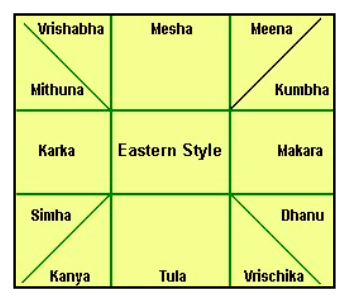
No style is better than the other, it is just a matter of familiarity. However, each style has an element attached to it, within Indian practice the diamond style has the Rajasic element attached to it, while south Indian havan style has Sattvic element attached to it.
Northern and Eastern charts are read anti clockwise, while South Indian chart is read clockwise.
No style is better than other, it is just what you are used to. What one practices more with, makes one accustomed to. Having said that, within Indian practice the diamond style has the Rajasic element attached to it, while south Indian havan style has Sattvic element attached to it. The charts are read with slight differences. The North and eastern ones are read antilock wise, while the South Indian is read clockwise.
In the north chart, the first house is also referred to as the As(Ascendent). Each house covers 30 degrees. The important thing to remember is that house numbers are not mentioned in the chart. So for example if you see a chart as below, the numbers correspond to the sign number
So in the above chart the number 10 appearing in house 1, refers to the 10th sign i.e. Markara (Capricon)
In the south Indian chart, the signs stay fixed and houses are moved, so the same above chart in south Indian style will look as follows.
The Ascendant occupies the location of Capricorn in the chart.
The Ascendant is called as the ‘Lagn’ is nothing but the sign rising on the east when the native is born. The planets are distributed with this reference and their position in the sky, akin to a screenshot of the sky at the point of birth. In this context, Rahu and Keto are mathematical points 180 degrees from each other. They have no physical presence, but they greatly impact our perspective of the celestial bodies (more on this later)
There are many other, hundreds of terms which one cannot all explain in this limited article. Like Hora which come Aho–Ratra, which indicate the hours. This concept plays important role in how the days of week are derived. For this simply arrange all the planet in ascending order of their speed around the sun:
Saturn – Jupiter – Mars – Sun– Venus- Mercury – Moon (Rahu Ketu don’t get this honour, nor the outer planets are considered)
The hours in a day, 24, are assigned to each planet every hour. We begin always with the king – Sun. So, the first day is Sunday, and the first hour of the first day belongs to the sun. Then we follow the cycle Sun – next Venus – next Mercury – next Moon -next Saturn – next Jupiter – next Mars and then back to the Sun, in a cyclic manner. The cycle is carried to the next day, for example the first day ends on Mercury, so the 1st hour of the next day begins with the Moon. The days also follow a cycle, Sunday to Saturday, back to Sunday. In the Indian concept, this cycle has no beginning nor an end, thus Indians do not have concept of weekends. Week can begin on any day, some calendars begin with the king, Sunday, some calendars in honor of ‘a guru’ begin with Guruwar (Thursday).
This is in contrast to the Abrahamic religions, wherein God made earth and life in 6 days, and rested on the 7th day, which gives us the concept of a weekend (rest day)
| Hora | Sunday | Monday | Tuesday | Wednesday | Thursday | Friday | Saturday |
| 1 | sun | moon | mars | mercury | jupiter | venus | saturn |
| 2 | venus | saturn | sun | moon | mars | mercury | jupiter |
| 3 | mercury | jupiter | venus | saturn | sun | moon | mars |
| 4 | moon | mars | mercury | jupiter | venus | saturn | sun |
| 5 | saturn | sun | moon | mars | mercury | jupiter | venus |
| 6 | jupiter | venus | saturn | sun | moon | mars | mercury |
| 7 | mars | mercury | jupiter | venus | saturn | sun | moon |
| 8 | sun | moon | mars | mercury | jupiter | venus | saturn |
| 9 | venus | saturn | sun | moon | mars | mercury | jupiter |
| 10 | mercury | jupiter | venus | saturn | sun | moon | mars |
| 11 | moon | mars | mercury | jupiter | venus | saturn | sun |
| 12 | saturn | sun | moon | mars | mercury | jupiter | venus |
| 13 | jupiter | venus | saturn | sun | moon | mars | mercury |
| 14 | mars | mercury | jupiter | venus | saturn | sun | moon |
| 15 | sun | moon | mars | mercury | jupiter | venus | saturn |
| 16 | venus | saturn | sun | moon | mars | mercury | jupiter |
| 17 | mercury | jupiter | venus | saturn | sun | moon | mars |
| 18 | moon | mars | mercury | jupiter | venus | saturn | sun |
| 19 | saturn | sun | moon | mars | mercury | jupiter | venus |
| 20 | jupiter | venus | saturn | sun | moon | mars | mercury |
| 21 | mars | mercury | jupiter | venus | saturn | sun | moon |
| 22 | sun | moon | mars | mercury | jupiter | venus | saturn |
| 23 | venus | saturn | sun | moon | mars | mercury | jupiter |
| 24 | mercury | jupiter | venus | saturn | sun | moon | mars |
Remember our perspective in all this is geocentric, i.e. earth is the center. It is the same reason why Sun (despite not being a planet) is a part of the structure, you can look at it as essentially replacing the earth in the scheme of things
Important thing to note here, ‘Nothing is written in Stone’, and a person has total freedom to practice at one’s will. Like in the Vedas, both astik’s and nastik’s find place.
The concept of ‘trinity’ common to many religions of the world is found in Jyotish also, because in essence Jyotish is Vedang i.e. a limb of the Veda. The trinity is ‘the mind’, ‘the body’, ‘the soul’ or Brhama, Vishnu, and Mahesh. In Manusmriti, Manu defines the length of the day for God in a relativistic notion – one day for God is one year of human life. The Sun movies 1 degree in Zodiac in a day, applying a relativistic notion, this 1 degree motion represents 1 human year. Take the circle, divide it into three parts – Mind, Body and Soul. Each part will be 120 degrees – corresponding to 120 human years. At 120 degrees (years), one part ends and the other begins, in Jyotish this lays the foundation of the belief that human life is 120 years. The ending of the this cycles is called Gadanta. We will see that each 120 degree point has its own significance in Jyotish. (later)
I have tried to cover a few basics of Jyotish, which I may be using in articles to come. The aim here was simple, to introduce how philosophy and astronomy are glued together in the language of mathematics. I have mentioned certain terms, their meaning without going much deep, only to avoid the preaching or trying to teach Jyotish.



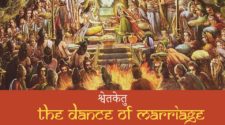



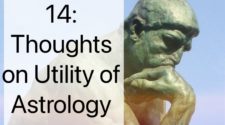


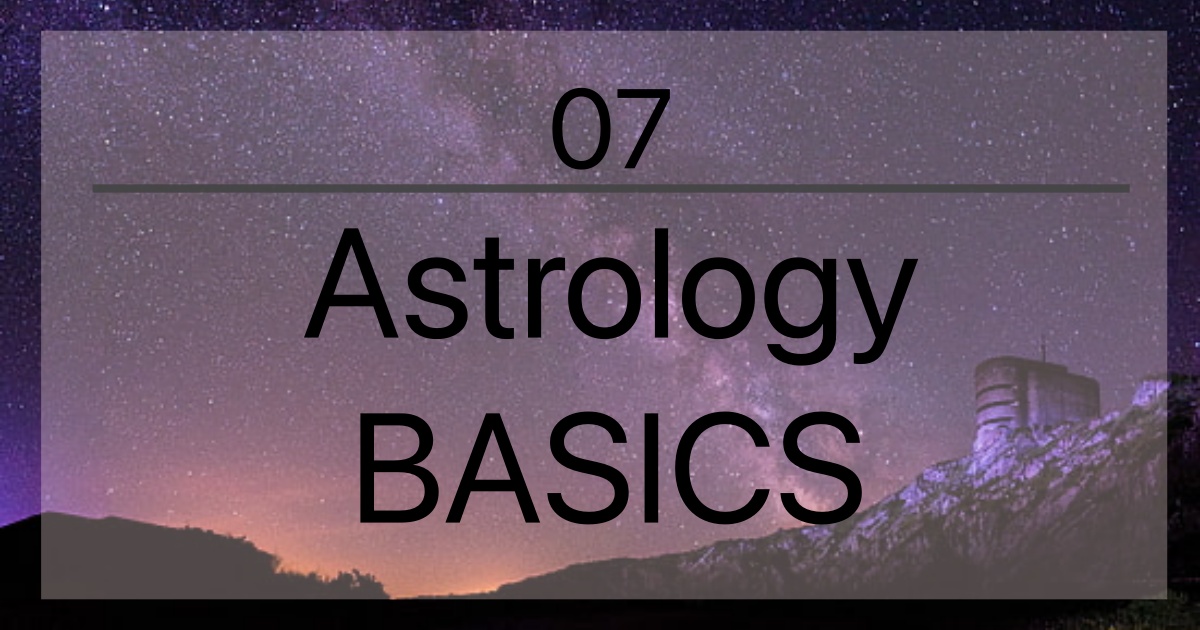



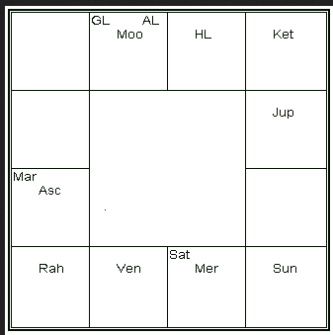
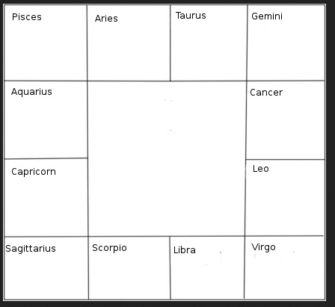



No Comment